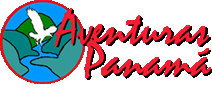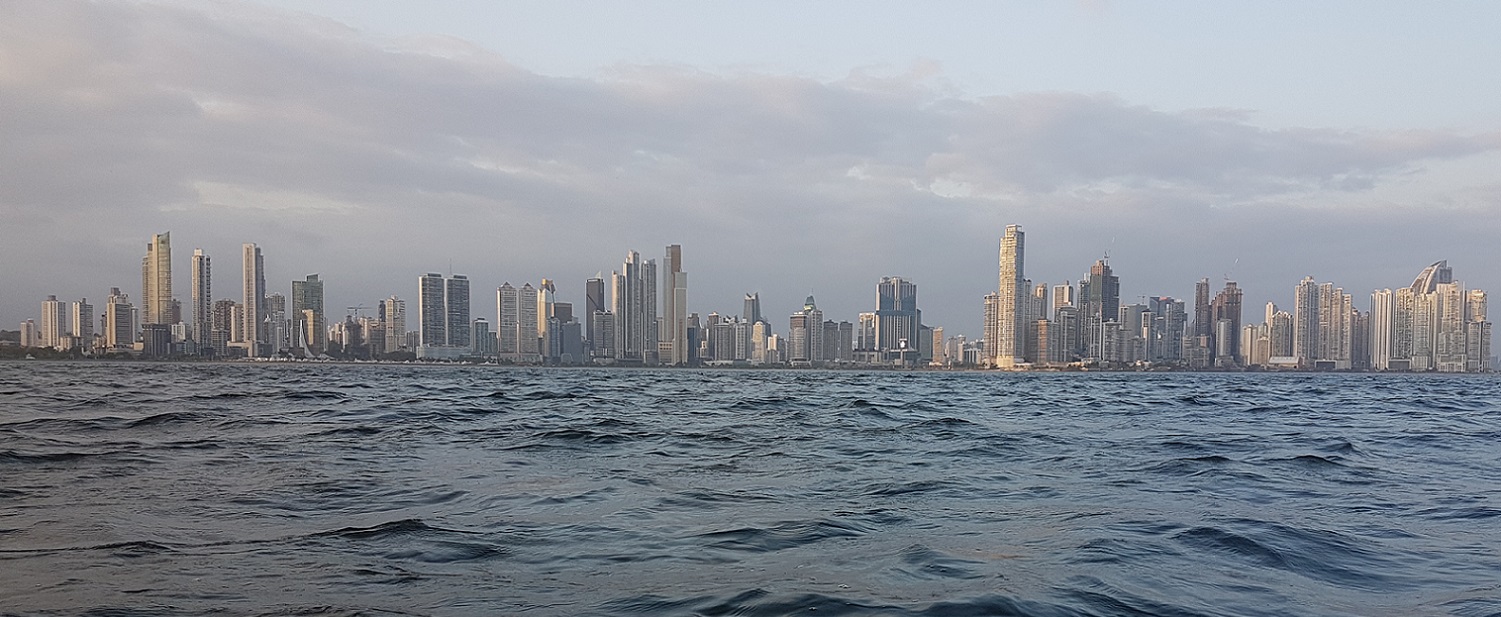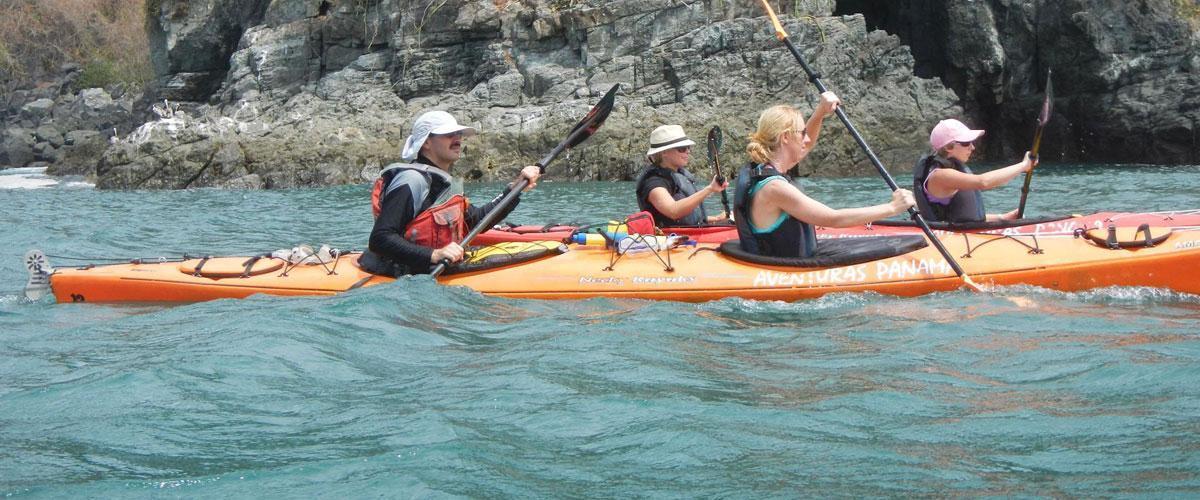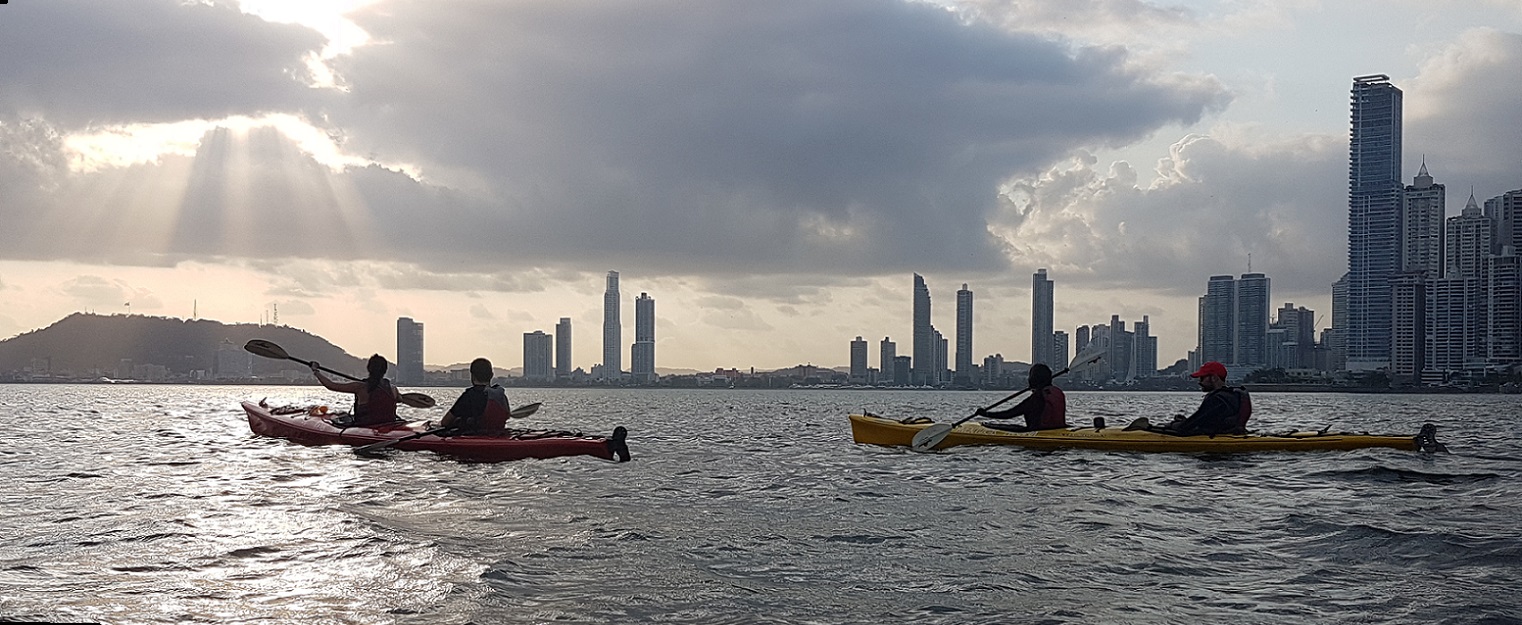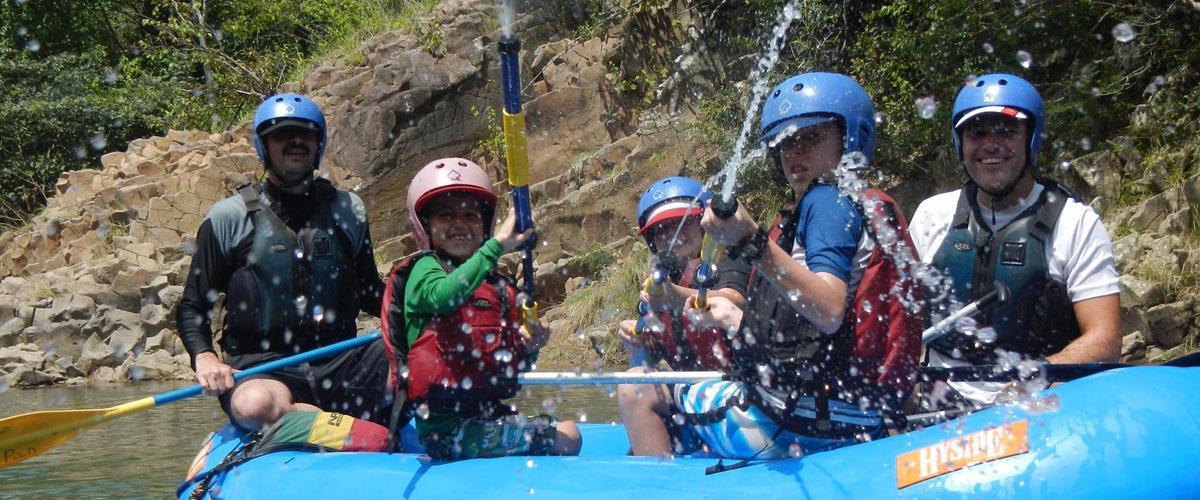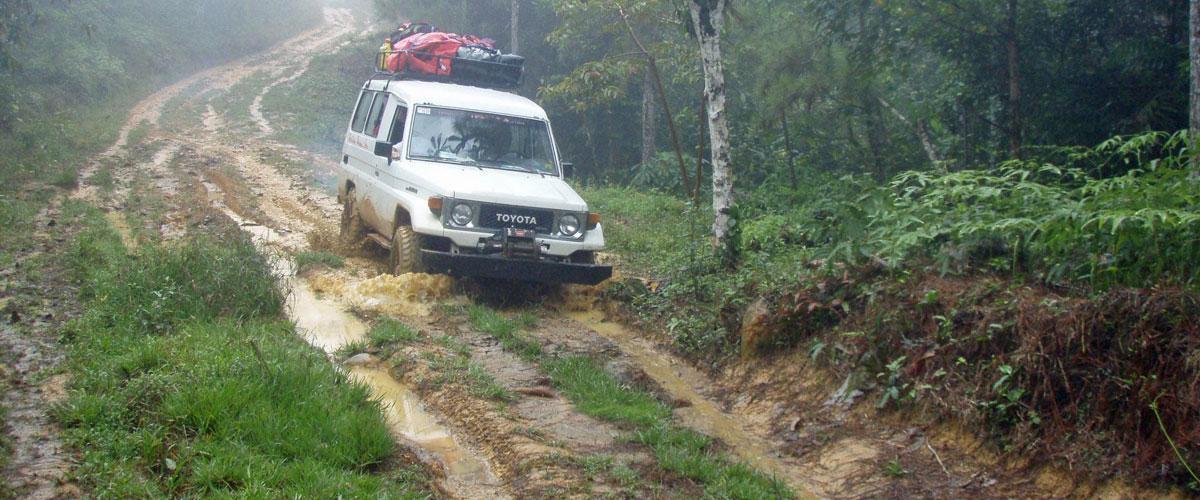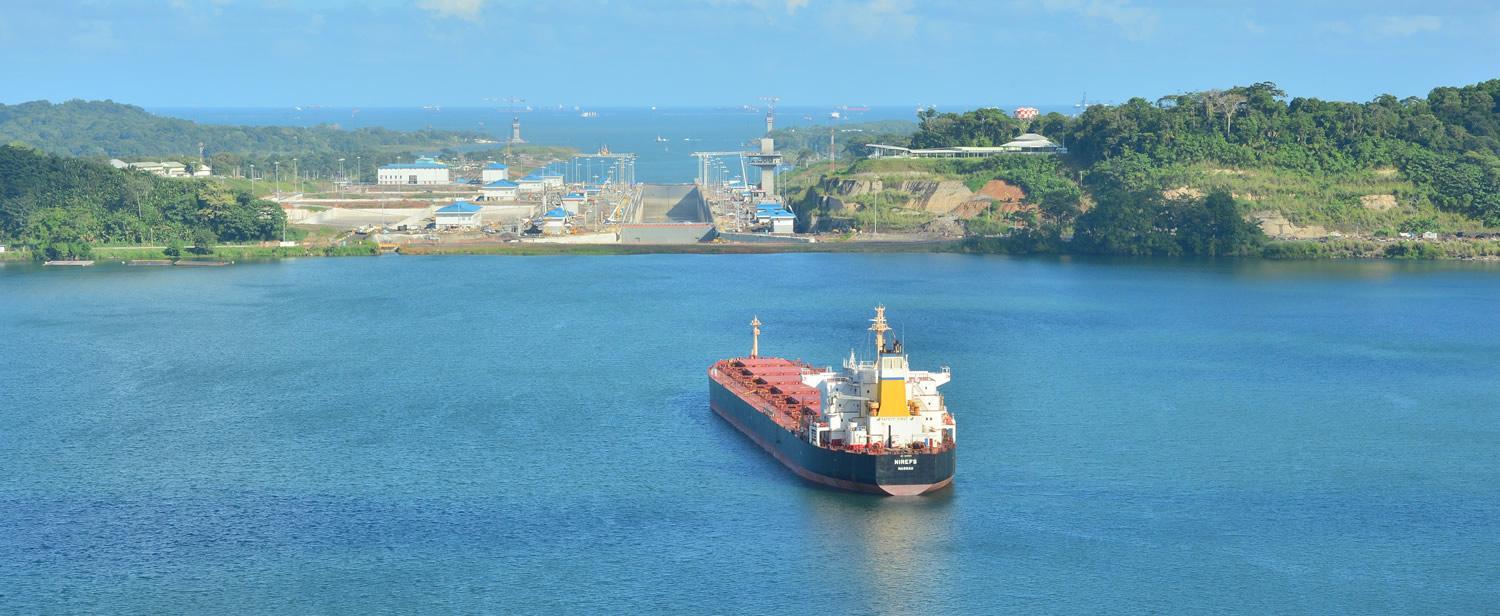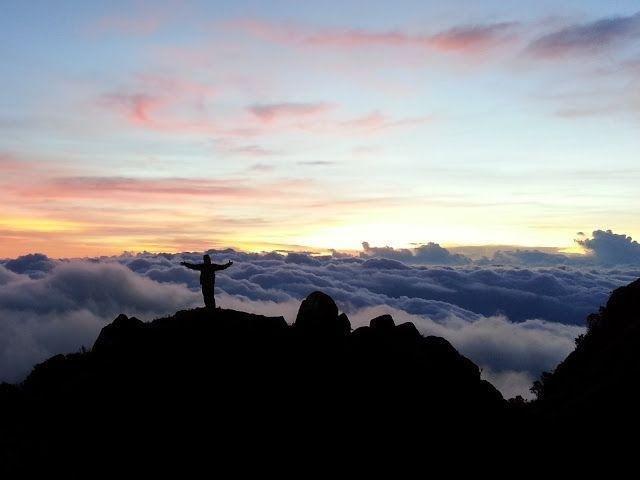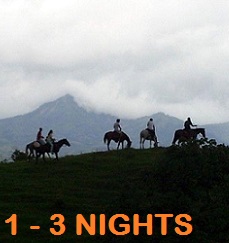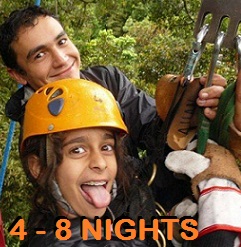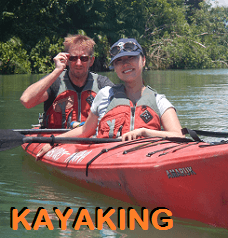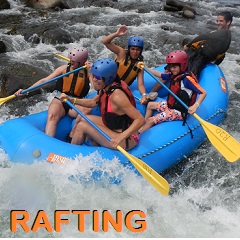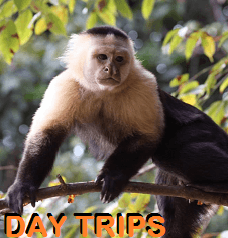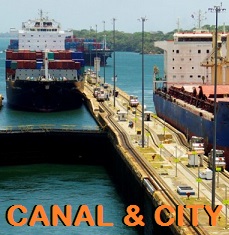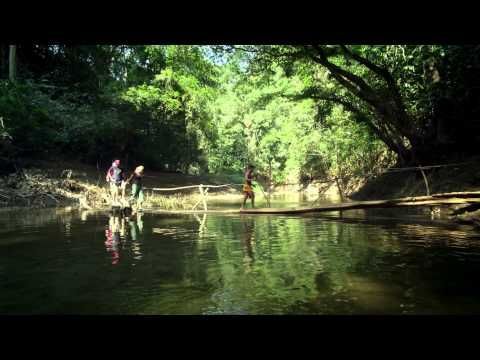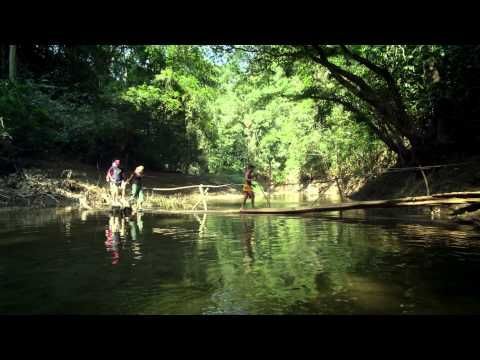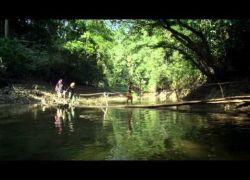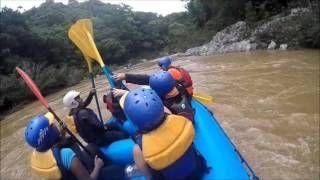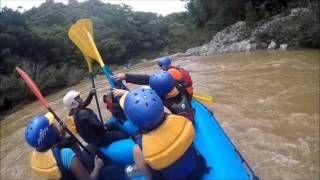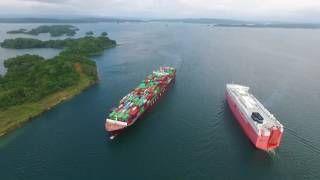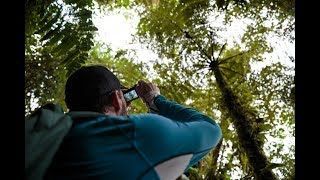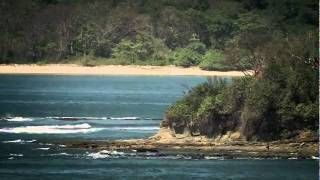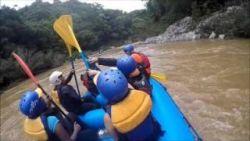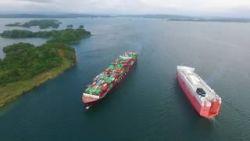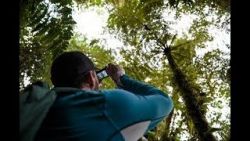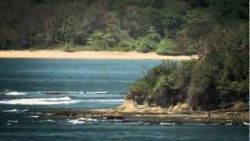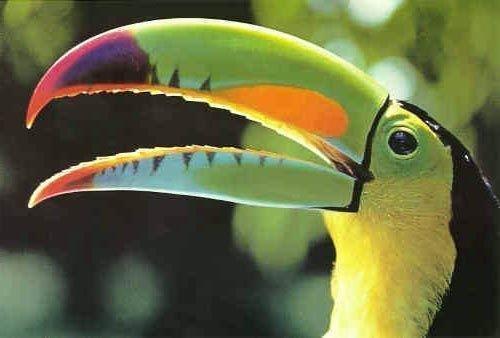
Paddle the Panama Canal through the Chagres River
HIGHLIGHTS
- 7 nights / 8 days all included package
- Embera Villages
- 4x4, hiking, rafting, kayaking...
- Pristine Chagres National Park
- Panama Canal
- Forth San Lorenzo
- Camping
- Gateway: Panama City
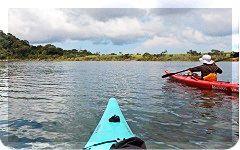 Can you kayak through the Panama Canal? If you love kayaking and you are looking for a trip that will test your skills, reveal rarely seen sceneries, and leave you satisfyingly exhausted, then you will enjoy a thorough exploration of the Chagres River, from beginning to end. And yes, the Panama Canal at Gatun Lake, from Gamboa to Gatun Locks, is nothing else than a section of the Chagres River.
Can you kayak through the Panama Canal? If you love kayaking and you are looking for a trip that will test your skills, reveal rarely seen sceneries, and leave you satisfyingly exhausted, then you will enjoy a thorough exploration of the Chagres River, from beginning to end. And yes, the Panama Canal at Gatun Lake, from Gamboa to Gatun Locks, is nothing else than a section of the Chagres River.
This itinerary takes you to experience the essence of Panama, its history, indigenous culture, nature, and the Panama Canal.
A dam at the river's northern terminus, just before it meets the Atlantic Ocean, forms Gatun Lake, which makes up the main water body of the Panama Canal. You'll hear the roar of howler monkeys from the vast jungle on your left and spot giant ships from a safe distance on your right as you paddle the length of Gatun Lake, sleeping as a guest in the huts of indigenous Embera tribes and wilderness camps along the way.
American interest in a convenient route between the Pacific and the Atlantic oceans was spurred from the gold rush of 1849 and led to the construction of the Panama Railway, finished in 1855. However, France began the first real efforts of building an inter-ocean waterway across the isthmus in 1881, but financial hardships and 22,000 deaths, largely due to disease, brought an end to the project 8 years later.
Americans picked up where the French left off and began a massive undertaking, completing the waterway in 1914, a project of great ambition that took 10 years and brought the Panama Canal to fruition. Currently, 4% of world commerce passes through the Canal annually, but a growing demand for global shipping efficiency has made necessary the construction of a thirs set of locks that will allow much larger vessels to pass through the Canal, a project completed in June 2016.
Every time a ship crosses the canal towards the Pacific Ocean at Miraflores or towards the Atlantic Ocean at the Gatun Locks, 52,000,000 gallons of fresh water are drawn from Gatun Lake, once the world's largest artificial lake. With the growing increase in traffic and with the addition of new locks, the demand for fresh water will continually rise.
Thanks to the Panama Canal, Soberania and Chagres National Parks were established to protect vast tropical forests that generate the Canal's main power source—fresh water. On this trip you'll not only explore the Canal itself, but venture into the heart of the jungle where an impressively large watershed forms the head waters of the Chagres, which is not only vital to the canal but also necessary for supplying the Panama City- Colón area with enough fresh water to support their growing populations.
You'll start off with a trek through Chagres National Park on our flagship trip, the Chagres Challenge. You'll visit a virtually unseen portion of the jungle, due to the lack of accessible roads, protection against settlers, and the previous non-existence of Adventures Panama. This part of the river, characterized by currents alternating with still waters, is considered Class II, although several rapids are considered Class III by the International Classification of River Navigation.
As a result of dense tropical forests covering the basin of the river, sedimentation is minimal; therefore, clear waters can often be expected. Local flora is typical of a tropical rain forest environment, with more than three hundred species per hectare. Although it is the natural habitat of big mammals, such as tapir and jaguar, they are seldom encountered. You can expect to see other exciting samples of fauna, such as rainforest monkeys (including: spider, howler, white faced capuchin, and Geoffroy's Tamarin), sloth, river otter, iguana, toucan, and plenty of fish. Once in the virgin jungle of Chagres National Park you will wonder if it might be the next set location of the popular TV show “Survivor.”
After this rafting portion of the trip, you'll switch into expedition kayaks and begin the real paddling as you cross Madden Lake ("Lago Alajuela"), before entering Gatun Lake alongside the Panama Canal. With the creation of Gatun Lake, many mountain tops were turned into islands. This area offers endless channel possibilities to scout. In its shores covered by dense tropical forest you will find all kinds of exotic flora and fauna. This was discovered by the Smithsonian Research Institute which has operated the famous Tropical Research Center at Barro Colorado since 1946, an Island you'll observe from your kayak as you paddle around it on your way across Gatun Lake.
At the Northern end of Gatun Lake, you'll once again enter the remnants of the Chagres, as you take the river from Gatun Dam all the way to the Caribbean, ending your time on the water with a tour of Fort Lorenzo, a fortress that once guarded Spanish conquistadors from the infamous Caribbean pirates.
View Panama Canal Chagres river all the way in a larger map
See Facebook related Album here
ITINERARY
1st day: Arrival to Panama City
We will greet you at Tocumen International Airport and shuttle you to a Panama City Hotel. At the hotel, we will hold a welcome meeting for the group at 7 p.m. in the lobby.
- Lodging at Hotel – no meals provided
2nd day: Miraflores Locks & Panama City Tour
We will pick you up at your hotel at 9 a.m. for a complete tour of the city. After all that paddling, you will have a relaxing and efficient tour around the more interesting sights, giving you both a historic and modern look at the city.
You will learn about the development of the Panama Canal and its economic impact at the Miraflores Locks. Here, you are able to see passing ships and you can enjoy a documentary about the creation of the canal, its economic and strategic impact, and the recent expansion of the Canal.
The Panama Canal Museum offers interesting artifacts and a close overview of the French and American approaches to constructing the canal. Once you are a Canal expert, we'll tour the city.
In Casco Antiguo, also called San Felipe, you will see a spectacular view of Panama City with visits to historic buildings such as San Jose Church, The National Theater, The Metropolitan Cathedral, The Old Slave Market and the Old Spanish Prisons.
You might also be interested in a visit to the Old Panama Ruins, a strategic spot for Spanish trade during colonial times.
On the Amador Causeway you will be in awe of the beautiful sight, here 3 islands were connected with the mainland by using materials from the Panama Canal excavations. You get to choose from several gourmet restaurants and enjoy the view of ships leaving the Canal and the exciting city.
- Lodging at Hotel – no meals provided
3rd day: Chagres Challenge
Get ready for an early start at 5 a.m. You will be picked up and taken in an all-terrain vehicle to the remote village of San Cristobal, which is past the mountains of Cerro Azul, northeast of Panama City.
After a wild 4x4 drive through our own made highway, you will hike for about 2-3 hours on a trail within Chagres National Park, up to Rio Piedras, a Chagres River tributary or all the way to Chagres River. Here you will get into rafts and float downstream (Class II-III rapids) into the untouched jungles of the upper basin of the Chagres River.
We will have lunch by the river and continue rafting further downstream passing an impressive granite canyon with some white water rapid action, and ending just before encountering Madden Lake, also known as Lake Alajuela. Along the route, you will be picked up by a “piragua” (native wooden canoe equipped with outboard motor) that will take you to the Embera Indian Village around 4-6 p.m.
These Embera Natives migrated to Chagres National Park more than 20 years ago, here they found habitat similar to the one they were familiar with in the Darien jungles, near Colombia. They are extremely friendly and will invite you into their village as honored guests. You will most likely set up camp under one of their banana roofed huts and be served their staple dinner of fried plantains and locally caught fish.
- Lodging at Embera Village – breakfast, lunch, dinner
4th day: Embera Indian Village
After thanking the Embera Natives for their kind hospitality, we will switch our rafts for expedition kayaks and begin paddling across Alhajuela Lake, for 3-4 hours.
You will paddle through the remains of a 'drowned forest,' where only the very tips of the tallest trees, that once thrived here, now barely break the surface of the water in this man-made lake. You will navigate through the water channels as you make your way to the public boat ramp of Nuevo Vigía, on the western coast of Alhajuela Lake. Here, the driver will meet you, and shuttle you across Madden Dam to a section of the Chagres that connects Alhajuela Lake to Gatun Lake.
This leg of the trip will take around 3 hours, you'll be able to spot wildlife on either side of the river, it's even possible to see small alligators. At the end of the day, around 4pm, you'll stop at another Embera village for the night, just short of Lake Gatun and the town of Gamboa. If they have ample space and resources, then you will once again indulge in their hospitality, setting up camp in a hut and eating locally sourced fish.
- Lodging at Embera Village – breakfast, lunch, dinner
5th day: Barro Colorado
In the morning, Embera Natives will once again shuttle you in piraguas, this time you will travel across to the west side of the Panama Canal. From here, your exploration of the canalthrough the original locks). With the expanded Canal, you might also see larger Neopanamax that are crossing through the newly inaugurated Third Set of Locks.
You will be paddling in a narrow channel reserved for smaller vessels just outside of the Panama Canal shipping lane, practically in the shadows of massive Panamax vessels (a name reserved for the largest possible ships that can traverse the canal).
Birds such as the king fisher and fishing eagles are common here. Ideally, you'll find a spot for lunch where you can watch turtles and Jesus Lizards (lizards with the ability to walk on water).
Eventually, you'll make your way around Barro Colorado, a famed Smithsonian natural research island. For this you have to rely on navigational techniques, to make your way through the tropical islands that guard the western passage around Barro Colorado.
At the end of the day, around 4 p.m. you'll set up a wilderness camp on a smaller island adjacent Barro Colorado.
- Lodging at Tent Camp – breakfast, lunch, dinner
6th day: Gatun Lake
After practicing 'leave no trace behind' techniques while taking down camp, you will truly put your paddling skills to the test as you tackle what remains of Gatun Lake, starting around 9 a.m.
Islands become less frequent in this section of the lake, and you will feel as if you are paddling through open waters, guided by a small lighthouse in the distance.
This section also offers unique views of large shipping vessels in the canal. You can track their steady progress from a distance, one after another as you yourself, travel alongside them.
Hopefully, you will find a nice shady lunch spot on one of the few islands in the middle of the lake, around noon.
On the far side of Gatun Lake you will see ships lined up, waiting for their turn to enter the locks and continue their passage through to the Atlantic Ocean. Large families of howler monkeys are known to roam the jungle forests in this area and will no doubt applaud your completion of Gatun Lake with their signature howl.
Here you will set up another wilderness camp just short of the Gatun Locks around 4pm
- Lodging at Tent Camp – breakfast, lunch, dinner
View Chagres River in Expedition Kayaks by Aventuras Panama in a larger map
7th day: Fort San Lorenzo
Today you will meet up with your driver who will take you to the north side of Gatun Dam and you'll start kayaking around 8:30 a.m.
You will be put in directly downstream of Gatun Dam just in time to watch the jungle awaken, likely encountering some morning mist. This is the final stretch of the Chagres River which flows into the Atlantic Ocean.
After 3-4 hours of paddling through dense tropical forest, you will reach the Caribbean, with a view of the old Spaniard conquistadors' Fort San Lorenzo. You will be transported back in time as you explore the remains of the once crucially important fortress, that starting in the XVI century, prevented Caribbean pirates from using the Chagres to launch surprise attacks on Panama City in the Pacific.
After visiting Fort San Lorenzo and having lunch, we will head back toward Panama City and reach the hotel around 4 p.m.
To get in and out of this area, by road, we will go across the Panama Canal by way of the ferry boat in our vehicle.
- Lodging at Hotel – breakfast, lunch
8th day: Departure
On the 8th day we will send you off with a shuttle back to the airport.
FREQUENTLY ASKED QUESTIONS
WHAT DOES IT INCLUDE?
All mentioned transportation, rafts or duckies, sea kayak(tandem or single) and related gear, camping gear, guides, trip's meals. Our guides are trained in river and sea navigation skills, first-aid and CPR.
All mentioned activities are guided and included
Lodging and catering:
3 nights at Hotel Marbella**, Panama City
2 nights in the huts of Embera Native Indian Villages
2 nights at Tent Campsite on the shores of Gatun Lake
8 breakfasts, 5 lunches, 4 dinners
Transfers:
All mentioned ground and ocean transfers within Panama are included.
WHAT DOES IT NOT INCLUDE?
International flight, Airport tax ($ 20.00/person), personal expenses, tips, meals not specified in itinerary, extras in hotels(laundry, room service, phone calls)
WHO CAN GO?
This land package is designed for couples, friends, or singles above 18 yrs old that enjoy to team up for paddling in the outdoors. Lodging has been chosen considering local style, comfortable and basic accommodation with out luxury.
However, any person from 12 to 65 years old, in good health, ready to walk for about two and a half hours through an irregular and muddy path could do it with slight modifications(Minors must travel with a responsible adult).
Private groups with some customization can be arranged.
WHAT SHOULD YOU TAKE ALONG?
Daily items: Swimsuit or a pair of shorts for navigating, sneakers or light boots with good soles, a cap, sun-block, a light jacket or windbreaker (in case the weather turns chilly), a towel and dry sets of clothes for after the day trip. Blanket, flashlight, personal hygiene items.
WHAT SHOULD NOT BE BROUGHT?
Objects than can be deteriorated by water or valuables like jewels, cash, credit cards, etc.
PRICES
2-3 persons $ 1,850.00
4-5 persons $ 1,550.00
6+ persons $ 1,450.00
SEASON
Kayak through the Panama Canal year-round !
The rainy season in Panama starts in April-May and ends by November-December. Due to changing river water levels it can not be defined in advance where we will stay the night on river shore.
From January through March a steady north wind prevails, that makes paddling difficult and may cause some necessary changes in the itinerary.
NOTES:
(1) Aventuras Panama reserves the right, at its sole criteria, to exchange program with similar activities or accommodations in case it considers it necessary.
(2) Participants should become familiar and agree with Aventuras Panama Terms and Conditions.
(3) We are subject to Panama Canal Authority regulation while paddling in Canal waters and eventually we might have to change in some degree out itinerary. For example, we can not paddle just below Gatun Dam when it releases massive excess water (it does pay to take a view of it)
HIGHLIGHTS
- 6 nights all inclusive package
- Explore the Panama Canal
- Paddle expedition kayaks
- Panama Canal eco tours Nature & wildlife
- Embera Village
- Historic Spaniard fortress
- Age: 17 and up
- Gateway: Panama City
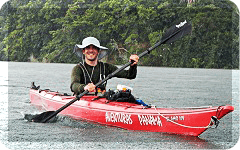 If you're an experienced sea kayaker looking for a trip that will test your skills, reveal rarely seen views, and leave you satisfyingly exhausted, then you will enjoy to explore the Panama Canal thorough the Chagres River, from Madden Lake to the Caribbean Ocean.
If you're an experienced sea kayaker looking for a trip that will test your skills, reveal rarely seen views, and leave you satisfyingly exhausted, then you will enjoy to explore the Panama Canal thorough the Chagres River, from Madden Lake to the Caribbean Ocean.
A dam at the river's northern terminus, just before it meets the Atlantic Ocean, forms Gatun Lake, which makes up the main body of the Panama Canal. You'll hear the roar of howler monkeys from the vast jungle on your left and spot giant ships from a safe distance on your right as you paddle the length of Gatun Lake, sleeping as a guest in the huts of indigenous Embera tribes and wilderness camps along the way.
American interest in a convenient route between the Pacific and the Atlantic oceans was spurred from the gold rush of 1849 and led to the construction of the Panama Railway, finished in 1855. But France began the first real efforts of building an inter-ocean waterway across the isthmus in 1881, but financial hardships and 22,000 deaths, largely due to disease, brought an end to the project 8 years later.
Americans picked up where the French left off and began a massive undertaking of completing the canal in 1904, a project of great ambition that took 10 years and brought the Panama Canal to fruition. Currently, 4% of world commerce passes through the canal annually, but a growing demand for global shipping efficiency has necessitated the construction of two new locks that will allow much larger vessels to pass through the canal, a project with an expected completion date in 2015.
Every time a ship crosses the canal toward the Pacific Ocean at Pedro Miguel Locks or toward the Atlantic Ocean at the Gatun Locks, 52,000,000 gallons of fresh water are bled from Gatun Lake, once the world's largest artificial lake. With the growing increase in traffic and with the addition of new locks, the demand for fresh water will continually rise.
Thanks to the Panama Canal, Soberania and Chagres National Parks were formed to protect vast tropical forests that procure the Canal's main power source—fresh water. On this trip you'll not only explore the canal itself, but venture into the heart of the jungle where an impressively large watershed forms the head waters of the Chagres, which is not only vital to the canal but also necessary for supplying the Panama City- Colón area with enough fresh water to support their growing populations.
You'll start off at the confluence of the Chagres River with Madden Lake to cross Madden Lake, before entering Gatun Lake alongside the Panama Canal. With the creation of Gatun Lake, many mountain tops were turned into islands. This area offers endless channel possibilities to scout. In its shores covered by dense tropical forest you will find all kinds of exotic flora and fauna. This was discovered by the Smithsonian Research Institute that has operated the famous Tropical Research Center of Barro Colorado since 1946, an Island you'll observe from your kayak as you paddle around it on your way across Gatun Lake.
At the Northern end of Gatun Lake, you'll once again enter the remains of the Chagres, as you take the river from Gatun Dam all the way to the Caribbean, ending your time on the water with a tour of Fort Lorenzo, a fortress that once guarded Spanish conquistadors from the infamous Caribbean pirates
Ver Panama Canal Chagres River in a larger map
ITINERARY
1st day: Arrival to Panama City
We will greet you at the Tocumen International Airport and shuttle you to a Panama City Hotel. At the hotel, we will hold a welcome meeting for the group at 7 p.m. in the lobby.
- Lodging at Hotel – no meals provided
2nd day: Miraflores Locks & Panama City Tour
We will pick you up at your hotel at 9 a.m. for a complete tour of the city. After all that paddling, you will have a relaxing and efficient tour around the more interesting sights, giving you both a historic and modern look at the city.
You will learn about the development of the Panama Canal and its economic impact at the Miraflores Locks. Here, you are able to see passing ships and you can enjoy a documentary about the creation of the canal, its economic and strategic impact, and the upcoming expansion of the Canal.
The Panama Canal Museum offers interesting artifacts and a close overview of the French and American approaches to constructing the canal. Once you are a canal expert, we'll tour the city.
In Casco Antiguo, also called San Felipe, you will see a spectacular view of Panama City with visits to historic buildings such as San Jose Church, The National Theater, The Metropolitan Cathedral, The Old Slave Market and the Old Spanish Prisons.
You might also be interested in a visit to the Old Panama Ruins, a strategic spot for Spanish trade during colonial times.
On the Amador Causeway you will be in awe of the beautiful sight, here 3 islands were connected with the mainland by using materials removed during the Panama Canal excavations. You get to choose from several gourmet restaurants and enjoy the view of ships leaving the Canal and exciting the city.
- Lodging at Hotel – Breakfast
3th day: Across Madden Lake all the way to Gamboa
We will be driven from Panama City to confluence of Chagres River into Madden Lake where our expedition kayaks journey begins and paddle across Madden Lake, for 3-4 hours.
You will paddle through the remains of a 'drowned forest,' where only the very tips of the tallest trees, that once thrived here, now barely break the surface of the water in this man-made lake. You will navigate through the water channels as you make your way to the public boat ramp of Nuevo Vigía, on the western coast of Madden Lake. Here, the driver will meet you, and shuttle you across Madden Dam to a section of the Chagres that connects Madden Lake to Gatun Lake.
This leg of the trip will take around 3 hours, you'll be able to spot wildlife on either side of the river, it's even possible to see small alligators. At the end of the day, around 4pm, you'll stop at an Embera village for the night, just short of Lake Gatun and the town of Gamboa. If they have ample space and resources, then you will indulge in their hospitality, setting up camp in a hut and eating locally sourced fish.
- Lodging at Embera Village – breakfast, lunch, dinner
4th day: Barro Colorado
In the morning, Embera Natives will shuttle you in piraguas, this time you will travel across to the west side of the Panama Canal. From here, your exploration of the canal really begins.
You will be paddling in a narrow channel reserved for smaller vessels just outside of the Panama Canal shipping lane, practically in the shadows of massive Panamax vessels (a name reserved for the largest possible ships that can traverse the canal).
Birds such as the king fisher and fishing eagles are common here. Ideally, you'll find a spot for lunch where you can watch turtles and Jesus Lizards (lizards with the ability to walk on water).
Eventually, you'll make your way around Barro Colorado, a famed Smithsonian natural research island. Relying on navigational techniques to make your way through the tropical islands that guard the western passage around Barro Colorado.
At the end of the day, around 4 p.m. you'll set up a wilderness camp on a smaller island adjacent Barro Colorado.
- Lodging at Tent Camp – breakfast, lunch, dinner
5th day: Gatun Lake
After practicing 'leave no trace behind' techniques while taking down camp, you will truly put your paddling skills to the test as you tackle what remains of Gatun Lake, starting around 9 a.m.
Islands become less frequent in this section of the lake, and you will feel as if you are paddling through open waters, guided by a small lighthouse in the distance.
This section also offers unique views of large shipping vessels in the canal. You can track their steady progress from a distance, one after another as you yourself, travel alongside them.
Hopefully, you will find a nice shady lunch spot on one of the few islands in the middle of the lake, around noon.
On the far side of Gatun Lake you will see ships lined up, waiting for their turn to enter the locks and continue their passage through the Atlantic Ocean. Large families of howler monkeys are known to roam the jungle forests in this area and will no doubt applaud your completion of Gatun Lake with their signature howl.
Here you will set up another wilderness camp just short of the Gatun Locks around 4pm
- Lodging at Tent Camp – breakfast, lunch, dinner
6th day: Fort Lorenzo
Today you will meet up with your driver who will take you to the north side of Gatun Dam and you'll start kayaking around 8:30 a.m.
You will putt in directly downstream of Gatun Dam just in time to watch the jungle awaken, likely encountering some morning mist. This is the final stretch of the Chagres River, that flows into the Atlantic Ocean.
After 3-4 hours of paddling through dense tropical forest, you will reach the Caribbean, with a view of the old Spaniard conquistadors' Fort San Lorenzo. You will be transported back in time as you explored the remains of the once crucially important fortress, that starting in the XVI century, prevented Caribbean pirates from using the Chagres to launch surprise attacks on Panama City in the Pacific.
After visiting Fort San Lorenzo and having lunch, we will head back toward Panama City and reach the hotel around 4 p.m.
To get in and out of this area, by road, we will go across the Panama Canal by way of the Gatun Locks in our vehicle. This is a one of a kind experience because these are the only locks designed as a vehicular bridge. We will get familiar with the lock's operation as we wait on passing ships as they cross through, giving us a first hand look at the lock process.
- Lodging at Hotel – breakfast, lunch
7th day: Departure
On the 8th day we will send you off with a shuttle back to the airport.
- Breakfast
FREQUENT ASKED QUESTIONS
WHAT DOES IT INCLUDE?
All mentioned transportation, rafts or duckies, sea kayak(tandem or single) and related gear, camping gear, guides, trip's meals. Our guides are trained in river and sea navigation skills, first-aid and CPR.
All mentioned activities are guided and included
Lodging and catering:
3 nights at Hotel Marbella**, Panama City
2 nights in the huts of Embera Native Indian Villages
2 nights at Tent Campsite on the shores of Gatun Lake
8 breakfasts, 5 lunches, 4 dinners
Transfers:
All mentioned ground and ocean transfers within Panama are included.
WHAT DOES NOT INCLUDE?
International flight, Airport tax ($ 20.00/person), personal expenses, tips, meals not specified in itinerary, extras in hotels(laundry, room service, phone calls)
WHO CAN GO?
This land package set departures are designed for couples, friends, or singles above 18 yrs old that enjoy to team up for paddling in the outdoors. Lodging has been chosen considering local style, comfortable and basic accommodation with out luxury.
However, any person from twelve to 65 years old, in good health, ready to walk for about two and a half hours through an irregular and muddy path could do it with minor modifications(Minors must travel with a responsible adult).
Private groups with some customization can be arranged.
WHAT SHOULD YOU TAKE ALONG?
Daily items: Swimsuit or a pair of short for navigating, sneakers or light boots with good soles, a cap, sun-block, a light jacket or windbreaker (in case the weather turns chilly), a towel and dry set of clothes for after the day trip. Blanket, flashlight, personal hygiene items.
WHAT SHOULD NOT BE BROUGHT?
At day tours leave object than can be deteriorated by water or valuables like jewels, cash, credit cards, etc.
PRICE:
2-3 persons $ 1,600.00
4-5 persons $ 1,250.00
6+ persons $ 1,200.00
Group leader will go free for a group of more than ten persons.
SEASON:
Explore the Panama Canal year-round.
The rainy season in Panama starts in April-May and ends by November-December. Due to changing river water level it can not be defined in advance where we will stay the night on river shore.
From January through March a steady north wind prevails, that makes paddling difficult and may cause some necessary changes in the itinerary.
NOTES:
(1) Aventuras Panama reserves the right, at its sole criteria, to exchange program with similar activities or accommodations in case it considers it necessary.
(2) Participants should get familiar and agree with Aventuras Panama Terms and Conditions.
HIGHLIGHTS
- 5 nights all included package
- Nature & Wildlife
- Paddle expedition kayaks
- Panama Canal Adventures
- All-inclusive package
- Historic Spaniard fortress
- Age: 17 and up
- Gateway: Panama City
If you're an experienced sea kayaker you will enjoy Panama Canal tours from Gamboa, it reveals rarely seen views, and leave you satisfyingly exhausted, then you will enjoy a thorough exploration of the Panama Canal Chagres River, from Gamboa to end.
A dam at the river's northern terminus, just before it meets the Atlantic Ocean, forms Gatun Lake, which makes up the main body of the Panama Canal. You'll hear the roar of howler monkeys from the vast jungle on your left and spot giant ships from a safe distance on your right as you paddle the length of Gatun Lake, sleeping in wilderness camps along the way.
The idea of a canal across the Isthmus of Panama was first envisioned by Charles V, the King of Spain in 1534. Spanish conquistadors at that time used the natural flow of the Chagres River to transport treasures from the new world to Spain. Mules hauled their plunders over land to Gamboa where they took smaller row boats along the Chagres River from Gamboa all the way to the Atlantic. Roughly the same expedition in which you'll explore in its modern capacity on days 4, 5, and 6 of this trip.
American interest in a convenient route between the Pacific and the Atlantic oceans was Spurred from the gold rush of 1849 and led to the construction of the Panama Railway, finished in 1855. But France began the first real efforts of building an inter-ocean waterway across the isthmus in 1881, but financial hardships and 22,000 deaths, largely due to disease, brought an end to the project 8 years later.
Americans picked up where the French left off and began a massive undertaking of completing the canal in 1904, a project of great ambition that took 10 years and brought the Panama Canal to fruition. Currently, 4% of world commerce passes through the canal annually, but a growing demand for global shipping efficiency has necessitated the construction of two new locks that will allow much larger vessels to pass through the canal, a project with an expected completion date in 2015.
Every time a ship crosses the canal toward the Pacific Ocean at Pedro Miguel Locks or toward the Atlantic Ocean at the Gatun Locks, 52,000,000 gallons of fresh water are bled from Gatun Lake, once the world's largest artificial lake. With the growing increase in traffic and with the addition of new locks, the demand for fresh water will continually rise.
Thanks to the Panama Canal, Soberania and Chagres National Parks were formed to protect vast tropical forests that procure the Canal's main power source—fresh water. On this trip you'll not only explore the canal itself, but venture into the heart of the jungle where an impressively large watershed forms the head waters of the Chagres, which is not only vital to the canal but also necessary for supplying the Panama City- Colón area with enough fresh water to support their growing populations.
You'll start off at the confluence of the Chagres River with Gatun Lake entering Gatun Lake alongside the Panama Canal. With the creation of Gatun Lake, many mountain tops were turned into islands. This area offers endless channel possibilities to scout. In its shores covered by dense tropical forest you will find all kinds of exotic flora and fauna. This was discovered by the Smithsonian Research Institute that has operated the famous Tropical Research Center of Barro Colorado since 1946, an Island you'll observe from your kayak as you paddle around it on your way across Gatun Lake.
At the Northern end of Gatun Lake, you'll once again enter the remains of the Chagres, as you take the river from Gatun Dam all the way to the Caribbean, ending your time on the water with a tour of Fort Lorenzo, a fortress that once guarded Spanish conquistadors from the infamous Caribbean pirates.
Ver Panama Canal Chagres River in a larger map
ITINERARY
1st day: Arrival to Panama City
We will greet you at the Tocumen International Airport and shuttle you to a Panama City Hotel. At the hotel, we will hold a welcome meeting for the group at 7 p.m. in the lobby.
Lodging at Hotel – no meals provided
2nd day: Miraflores Locks & Panama City Tour
We will pick you up at your hotel at 9 a.m. for a complete tour of the city. After all that paddling, you will have a relaxing and efficient tour around the more interesting sights, giving you both a historic and modern look at the city.
You will learn about the development of the Panama Canal and its economic impact at the Miraflores Locks. Here, you are able to see passing ships and you can enjoy a documentary about the creation of the canal, its economic and strategic impact, and the upcoming expansion of the Canal.
The Panama Canal Museum offers interesting artifacts and a close overview of the French and American approaches to constructing the canal. Once you are a canal expert, we'll tour the city.
In Casco Antiguo, also called San Felipe, you will see a spectacular view of Panama City with visits to historic buildings such as San Jose Church, The National Theater, The Metropolitan Cathedral, The Old Slave Market and the Old Spanish Prisons.
You might also be interested in a visit to the Old Panama Ruins, a strategic spot for Spanish trade during colonial times.
On the Amador Causeway you will be in awe of the beautiful sight, here 3 islands were connected with the mainland by using materials removed during the Panama Canal excavations. You get to choose from several gourmet restaurants and enjoy the view of ships leaving the Canal and exciting the city.
Lodging at Hotel – breakfast
3th day: Barro Colorado
You will be driven to Gamboa at the confluence of Chagres River with Gatun Lake where we will start paddling across to the west side of the Panama Canal. From here, your exploration of the canal really begins.
You will be paddling in a narrow channel reserved for smaller vessels just outside of the Panama Canal shipping lane, practically in the shadows of massive Panamax vessels (a name reserved for the largest possible ships that can traverse the canal).
Birds such as the king fisher and fishing eagles are common here. Ideally, you'll find a spot for lunch where you can watch turtles and Jesus Lizards (lizards with the ability to walk on water).
Eventually, you'll make your way around Barro Colorado, a famed Smithsonian natural research island. Relying on navigational techniques to make your way through the tropical islands that guard the western passage around Barro Colorado.
At the end of the day, around 4 p.m. you'll set up a wilderness camp on a smaller island adjacent Barro Colorado.
Lodging at Tent Camp – breakfast, lunch, dinner
4th day: Gatun Lake
After practicing 'leave no trace behind' techniques while taking down camp, you will truly put your paddling skills to the test as you tackle what remains of Gatun Lake, starting around 9 a.m.
Islands become less frequent in this section of the lake, and you will feel as if you are paddling through open waters, guided by a small lighthouse in the distance.
This section also offers unique views of large shipping vessels in the canal. You can track their steady progress from a distance, one after another as you yourself, travel alongside them.
Hopefully, you will find a nice shady lunch spot on one of the few islands in the middle of the lake, around noon.
On the far side of Gatun Lake you will see ships lined up, waiting for their turn to enter the locks and continue their passage through the Atlantic Ocean. Large families of howler monkeys are known to roam the jungle forests in this area and will no doubt applaud your completion of Gatun Lake with their signature howl.
Here you will set up another wilderness camp just short of the Gatun Locks around 4pm
Lodging at Tent Camp – breakfast, lunch, dinner
5th day: Fort Lorenzo
Today you will meet up with your driver who will take you to the north side of Gatun Dam and you'll start kayaking around 8:30 a.m.
You will putt in directly downstream of Gatun Dam just in time to watch the jungle awaken, likely encountering some morning mist. This is the final stretch of the Chagres River, that flows into the Atlantic Ocean.
After 3-4 hours of paddling through dense tropical forest, you will reach the Caribbean, with a view of the old Spaniard conquistadors' Fort San Lorenzo. You will be transported back in time as you explore the remains of the once crucially important fortress, that starting in the XVI century, prevented Caribbean pirates from using the Chagres to launch surprise attacks on Panama City in the Pacific.
After visiting Fort San Lorenzo and having lunch, we will head back toward Panama City and reach the hotel around 4 p.m.
To get in and out of this area, by road, we will go across the Panama Canal by way of the Gatun Locks in our vehicle. This is a one of a kind experience because these are the only locks designed as a vehicular bridge. We will get familiar with the lock's operation as we wait on passing ships as they cross through, giving us a first hand look at the lock process.
Lodging at Hotel – breakfast, lunch
6th day: Departure
On the 8th day we will send you off with a shuttle back to the airport.
– breakfast
FREQUENT ASKED QUESTIONS
WHAT DOES IT INCLUDE?
All mentioned transportation, rafts or duckies, sea kayak(tandem or single) and related gear, camping gear, guides, trip's meals. Our guides are trained in river and sea navigation skills, first-aid and CPR.
All mentioned activities are guided and included
Lodging and catering:
3 nights at Hotel Marbella**, Panama City
2 nights in the huts of Embera Native Indian Villages
2 nights at Tent Campsite on the shores of Gatun Lake
8 breakfasts, 5 lunches, 4 dinners
Transfers:
All mentioned ground and ocean transfers within Panama are included.
WHAT DOES NOT INCLUDE?
International flight, Airport tax ($ 20.00/person), personal expenses, tips, meals not specified in itinerary, extras in hotels(laundry, room service, phone calls)
WHO CAN GO?
This land package set departures are designed for couples, friends, or singles above 18 yrs old that enjoy to team up for paddling in the outdoors. Lodging has been chosen considering local style, comfortable and basic accommodation with out luxury.
However, any person from twelve to 65 years old, in good health, ready to walk for about two and a half hours through an irregular and muddy path could do it with minor modifications(Minors must travel with a responsible adult).
Private groups with some customization can be arranged.
WHAT SHOULD YOU TAKE ALONG?
Daily items: Swimsuit or a pair of short for navigating, sneakers or light boots with good soles, a cap, sun-block, a light jacket or windbreaker (in case the weather turns chilly), a towel and dry set of clothes for after the day trip. Blanket, flashlight, personal hygiene items.
WHAT SHOULD NOT BE BROUGHT?
At day tours leave object than can be deteriorated by water or valuables like jewels, cash, credit cards, etc.
PRICE:
2-3 persons $ 1,200.00
4-5 persons $ 1,100.00
6+ persons $ 1,000.00
Group leader will go free for a group of more than ten persons.
SEASON:
Panama Canal tours from Gamboa is a year-round package.
The rainy season in Panama starts in April-May and ends by November-December. Due to changing river water level it can not be defined in advance where we will stay the night on river shore.
From January through March a steady north wind prevails, that makes paddling difficult and may cause some necessary changes in the itinerary.
NOTES:
(1) Aventuras Panama reserves the right, at its sole criteria, to exchange program with similar activities or accommodations in case it considers it necessary.
(2) Participants should get familiar and agree with Aventuras Panama Terms and Conditions.
